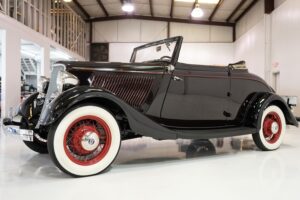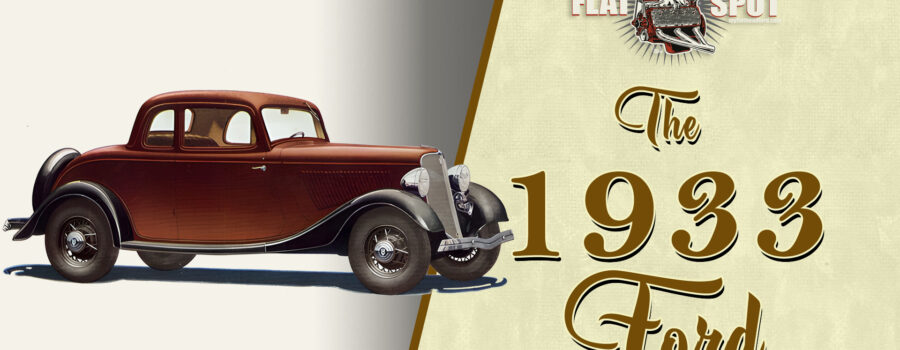
When the Model 40 and the new B were introduced February 9, 1933, revisions of the car were substantial, especially considering how important the 1932 change had been. For its second year, the wheelbase was stretched, from 106 in (2692 mm) to 112 in (2845 mm) on a new crossmember frame. The grille was revised, gaining a pointed forward slope at the bottom which resembled either a spade, a Medieval shield, or possibly the 1932 Packard Light Eight in general outline anyway. Both the grille and hood louvers curved down and forward. The overall design and grille were inspired by the English Ford Model Y. Streamlining was further accentuated by the new hood which now covered the cowl, giving an impression of more length. In addition, there were more rounded and skirted fenders and new, elegantly bowed bumpers. Headlamp support bars were no longer in use, and there were new wire wheels. The cars got a new dashboard with instruments set in an oval insert in front of the driver. There was a glove box on the passenger side. Closed Deluxe models received heavy DI-NOC woodgraining on dash and window frames, and there were deeper seat cushions.

There were 10 body styles (14 if standard and Deluxe trim levels are counted separately). Now, all were available for V-8s and the Model B, which thus got Deluxe models, too. Convertible Coupes and Victoria came in Deluxe trim only, and the most expensive car in the line, the “woody”, as a Standard only. It cost US$590 with the four-cylinder engine.
The cars gained about 3 percent in weight, compensated for with more powerful engines, as on the V-8 with its 15 percent increase in power.

“Model C”
Power from the V8 rose to 75 hp (56 kW) with a revised ignition system. The four-cylinder engine continued unchanged, but was referred to (by some) as the Model C, though Ford never referred to its “Improved Four-Cylinder engine” as a “Model C” engine. There is some dispute over this; some sources say it was a common misconception due to the introduction of a larger counterbalanced crankshaft during the Model B engine production, and the letter “C” casting mark on most, but not all, of the Model B heads. On the other side, this integrally counter weighted crankshaft was first introduced for truck engines only. When they proved superior concerning smoothness and longevity, they were introduced for worldwide four cylinder production. Together with the fact that there were huge quantities of “B” code engines in stock that needed to be used up, this explains why there are “B” and “C” coded engines in some model years. As Canadian-built cars used the prefix “C” on their identification plates, there is another source for errors. Model Bs start with prefix “AB”, V-8s with “18-1”. (Model A part number suffix was ‑A, Police Special High Compression head part number suffix was ‑b, and there was a fairly large letter “B” casting mark about the center of the head.)








